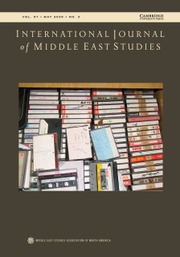No CrossRef data available.
Article contents
Multiplicities of Purpose: The Auditorium Building, the State, and the Transformation of Arab Digital Media
Published online by Cambridge University Press: 27 April 2015
Extract
Digital media played a key role in a number of uprisings that later became known as the Arab Spring. Now that this moment of resistance has largely given way to a tumultuous and unsettled regional order, we can ask what role these media forms are playing in the new ecology of the postuprisings Middle East. I would argue that we are witnessing a period of experimentation—journalists are attempting to generate both revenue and dissent under circumstances that range from unsettled (Tunisia) to increasingly repressive (Jordan), while proto-state actors and transnational jihadis are exploiting social media to attract supporters and influence diverse audiences. What is clear is that in many states the digital arrangement that characterized the 2000s—activist bloggers squaring off openly with recalcitrant and often clueless states—is gone. States are now more aware of and careful about the strategies they employ vis-à-vis digital dissent. In places such as Egypt, some of the most vocal activists are in prison. In Jordan, they have returned to producing journalism that skirts the line between tolerated and forbidden. Across the region digital media activists are grappling with disillusionment about the trajectory of the Arab Spring, while digital spaces are sites for transnational contestation, including by the most successful challenger to the state system since Jamal ʿAbd al-Nasir in the 1950s, the Islamic State (IS). ʿAbd al-Nasir famously used radio to breach the information firewalls erected by new Arab states. IS has similarly employed the technologies of the day to execute a plan of even greater ambition and reach—far from reaching out only across national boundaries within the subsystem, IS militants have crafted a transnational media operation of remarkable scope, one that has drawn tens of thousands of recruits not only from the Middle East but also from Europe, the United States, and Asia.
- Type
- Roundtable
- Information
- Copyright
- Copyright © Cambridge University Press 2015
References
NOTES
1 See Ross Dawson, “Updating the Newspaper Extinction Timeline for the Arab World,” Trends in the Living Networks, 21 May 2014, accessed 18 December 2014, http://rossdawsonblog.com/weblog/archives/2014/05/updating-newspaper-extinction-timeline-arab-world.html.
2 Ramsey George, author's interview, Amman, Jordan, 24 March 2014.
3 Elsayed, Yomna, “Facebook-only Social Journalism on a Budget,” Arab Media and Society 17 (2013): 1–27Google Scholar.
4 Author's correspondence with ʿAbd Allah al-Fakharany, 19 December 2014. At the time of this writing, al-Fakharany is still being held at Wadi al-Natrun prison.
5 Johnson, Steven, Future Perfect: The Case for Progress in a Networked Age (New York: Penguin Books, 2012)Google Scholar.
6 Hashem, Ali, “The Islamic State's Social Media Strategy,” Al-Monitor, 18 August 2014Google Scholar, accessed 18 December 2014, http://www.al-monitor.com/pulse/originals/2014/08/is-clinton-atrocities-social-media-baghdadi-mccain.html&num#.


